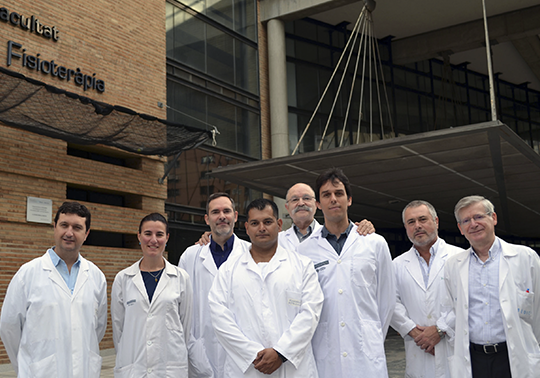Researchers in Physiotherapy develop an experimental model in rabbits to investigate the metabolic syndrome
- May 31st, 2017

A research group of the Universitat de València has developed an animal experimental model of metabolic syndrome, a pathology which combines some metabolic and cardiovascular alterations such as obesity, glucose intolerance, dyslipidaemia and high blood pressure. This model, published in the journal ‘Plos One’, could be useful for the study of the disease and the identification of the markers in the pre-clinical and clinical setting which are necessary to identify patients in risk of developing the metabolic syndrome.
In basic research, some models of rodents (rat and mouse) are usually used in the study of the metabolic syndrome. These rodents differ from humans regarding the lipid metabolism. Furthermore, not all the species develop high blood pressure, obesity and blood sugar and insulin disorders. The article shows an animal model in white rabbits that came from New Zealand. This model reproduces the main components of the metabolic syndrome in human and “for that reason, it has a great potential of movement”, states Manuel Zarzoso, researcher of the Department of Physiotherapy of the Universitat de València.
The workj has developed an experimental model of the metabolic syndrome induced by the diet, which is characterized by obesity, high blood pressure, pre-diabetes and dyslipidaemia, and reproduces the main clinical manifestations of this disease in humans. “The use of this non-transgenic model induced by diet is important, given that the diet affects globally the organism through its effects on the hormones, the glucose metabolism, lipid metabolism ways and its effects on the regulation of the several organs and systems”, claims Manuel Zarzoso.
The research has been carried out by the departments of Physiotherapy, Physiology, Medicine and Pathology as well as the Central Unit for Research in Medicine of the Universitat de València, the Institute for Health Research INCLIVA and the department of Cardiology of the Hospital Clinico in Valencia.
The research methodology consists on feeding the animals with a high-fat and sugar diet during 28 weeks and evaluating, in several stages, different morphological parameters, blood pressure and blood sugar. Also, it has been analysed several plasma biochemical parameters, structural changes in liver and plasma metabolomics profile.
Among the benefits of this experimental model, it can be highlighted that the model “could be used for future researches about the development of the disease and the condition of the clinical manifestation of the pathology. So, it will be possible to identify the pre-clinical and clinical markers that allow to detect patients in risk”, according to Manuel Zarzoso. Furthermore, the experimental model could contribute to the study of the mechanisms underlying the cardiovascular, metabolic and hormonal problems related to the metabolic syndrome, especially in the study of the cardiovascular remodelling, arrhythmias and sudden cardiac death.
This model is cheaper than other experimental procedures which work with bigger animals. “The work using the white rabbit of New Zealand is more economical than those models which use pigs and are more expensive and complex”, has said the researcher of the Universitat de València.
Metabolic syndrome
The sedentary lifestyle and excessive energy consumption from processed food rich in saturated fat and refined sugar have turned the obesity and the metabolic syndrome into an authentic global epidemic. Likewise, the metabolic syndrome is associated with an increase in the risk of cardiovascular diseases, type II diabetes and non-alcoholic hepatic disease, so this produces high costs in health systems. Furthermore, the incidence of heart arrhythmia and sudden death is higher in people with cardiovascular and metabolic disorders.
This project is financed by the Valencian Government (PROMETEO, GV2015-062), Universitat de València (UV-INV-PRECOMP14-206372), the Ministry of Economy, Industry and Commerce, and the Health Institute of Carlos III in Madrid.
Article:
Arias-Mutis OJ, Marrachelli VG, Ruiz-Saurí A, Alberola A, Morales JM, Such-Miquel L, et al. (2017) «Development and characterization of an experimental model of diet-induced metabolic syndrome in rabbit». PLoS ONE 12(5): e0178315.
File in: Grups de recerca , Fisioteràpia , Fisiologia , Medicina , Patologia
















